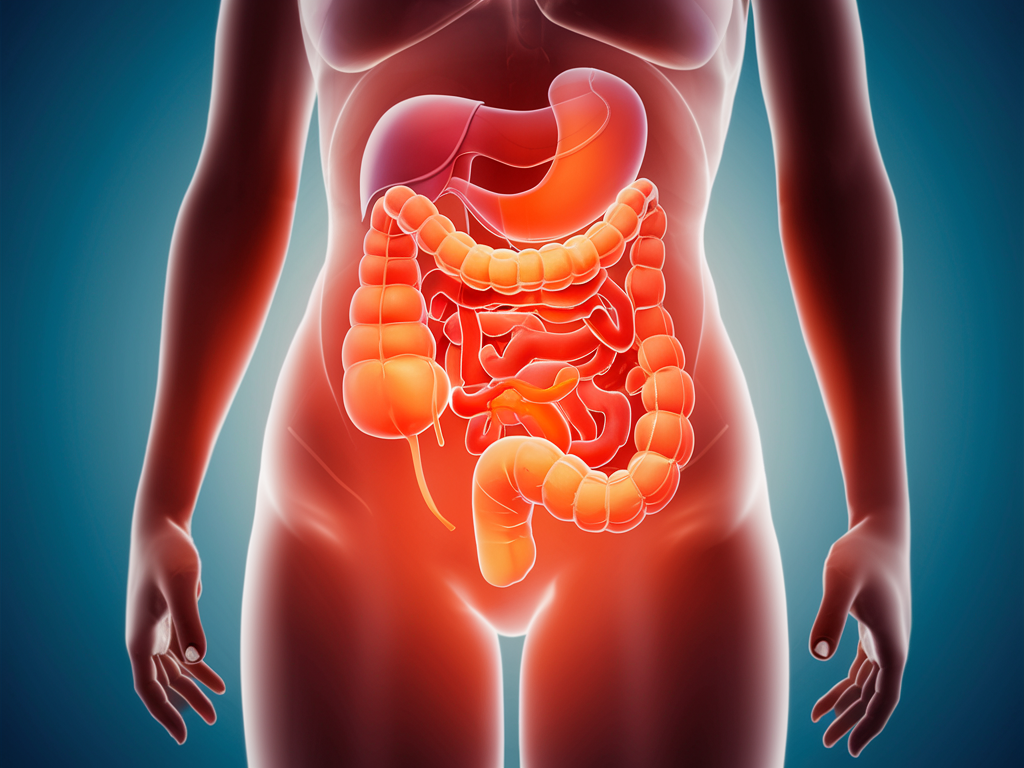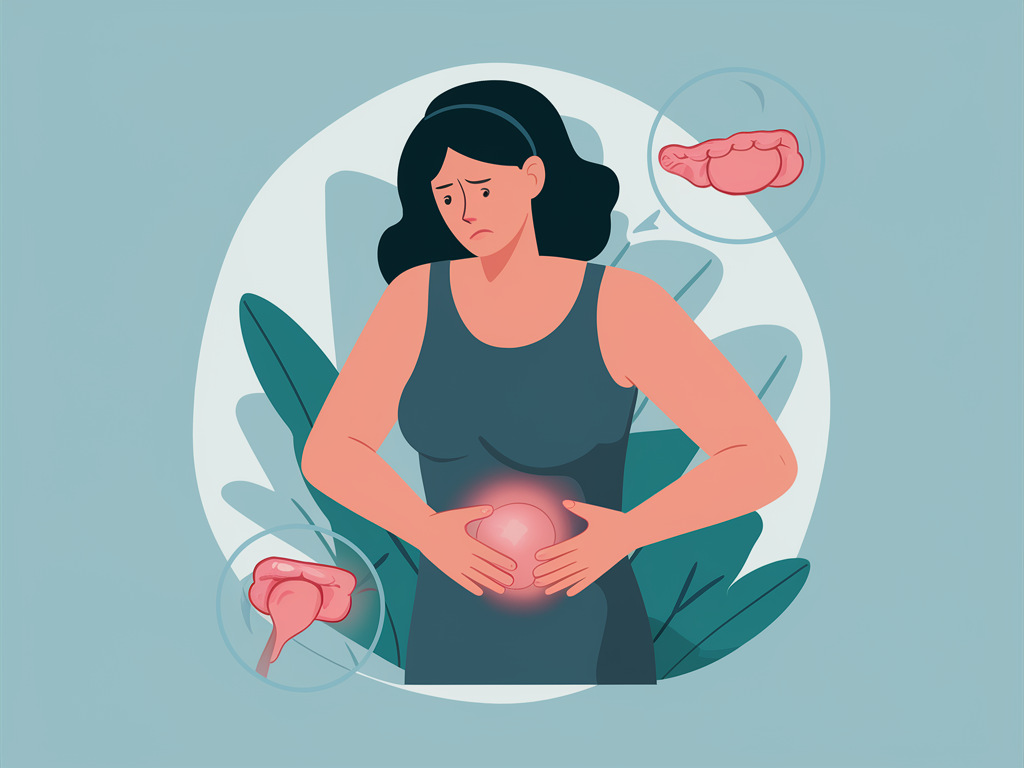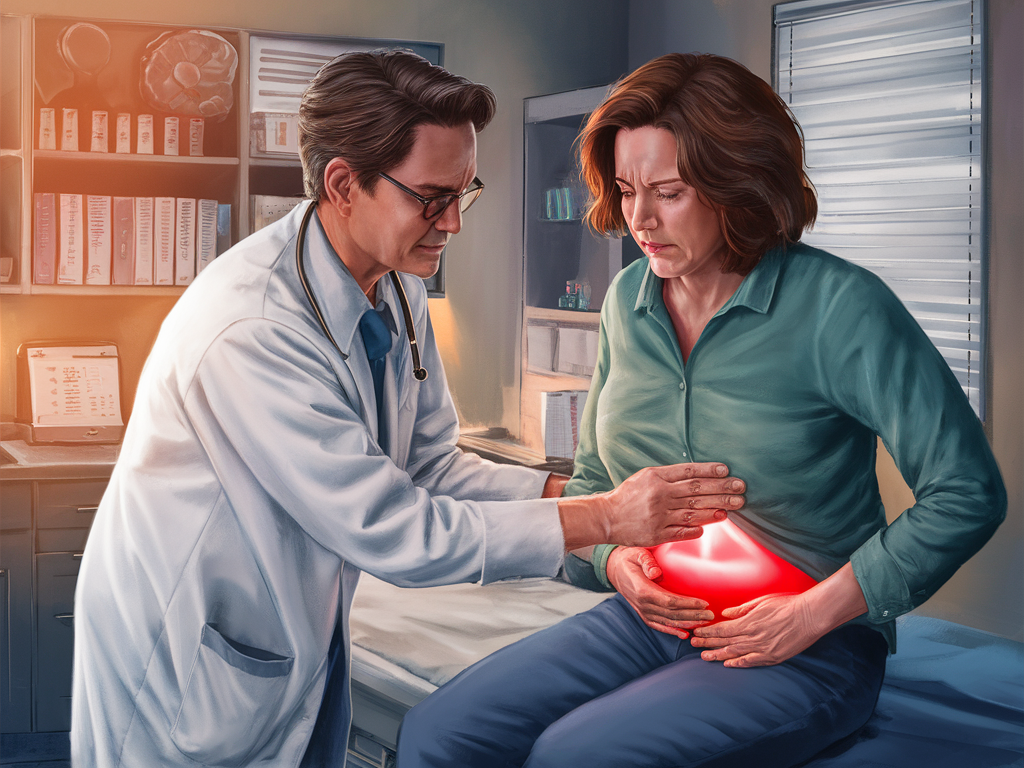Experiencing discomfort in the lower right portion of your abdomen can be concerning and confusing. This specific area houses several vital organs and structures, including part of your colon, appendix, right ovary and fallopian tube in women, and portions of your urinary system. When pain develops in this region, it could signal anything from a minor, temporary issue to a serious medical emergency requiring immediate attention.
Understanding the potential causes of lower right abdominal pain can help you make informed decisions about your health and know when it’s appropriate to seek medical care. This comprehensive guide explores the twelve most common causes of pain in this specific region, along with warning signs that indicate you should consult a healthcare provider promptly.

Cause #1: Appendicitis
Appendicitis occurs when the appendix, a small, finger-shaped pouch attached to your large intestine, becomes inflamed and infected. This condition is one of the most common causes of severe abdominal pain requiring surgical intervention.
Typically, appendicitis begins with pain near the navel that gradually shifts to the lower right abdomen, becoming more intense over several hours. The pain often intensifies with movement, coughing, or deep breathing. Additional symptoms include:
- Fever (usually low-grade initially)
- Nausea and vomiting
- Loss of appetite
- Abdominal swelling
- Inability to pass gas
Appendicitis requires immediate medical attention as a ruptured appendix can lead to peritonitis, a serious infection that can be life-threatening. Appendectomy (surgical removal of the appendix) is the standard treatment for appendicitis, often performed laparoscopically.
Cause #2: Kidney Stones
Kidney stones form when minerals and salts in your urine crystallize and build up inside your kidneys. When these stones move through your urinary tract, they can cause excruciating pain, particularly if they lodge in your ureter (the tube connecting your kidney to your bladder).
When a stone affects your right kidney, you may experience:
- Severe, sharp pain that comes in waves
- Pain radiating from your lower back to your groin
- Blood in urine (hematuria)
- Cloudy or foul-smelling urine
- Nausea and vomiting
- Frequent urination
- Burning sensation during urination
Treatment depends on the size and location of the stone. Small stones may pass naturally with increased fluid intake and pain management. Larger stones might require medical interventions such as extracorporeal shock wave lithotripsy (ESWL), ureteroscopy, or in rare cases, surgical removal.
Cause #3: Ovarian Cysts (in women)
Ovarian cysts are fluid-filled sacs that develop on or inside the ovaries. When these cysts form on the right ovary, they can cause pain in the lower right abdomen. Most ovarian cysts are harmless and often resolve without treatment.
Common types include:
- Follicular cysts: Form when an ovarian follicle doesn’t release an egg
- Corpus luteum cysts: Develop after an egg has been released
- Dermoid cysts: Contain tissue like hair, skin, or teeth
- Endometriomas: Associated with endometriosis
- Cystadenomas: Develop from cells on the surface of the ovary
Symptoms of right ovarian cysts may include:
- Dull or sharp pain on the right side
- Bloating or swelling
- Painful intercourse
- Changes in menstrual patterns
While most cysts are benign, immediate medical attention is necessary if you experience sudden, severe pain with fever or vomiting, as this could indicate a ruptured cyst or ovarian torsion (twisting of the ovary).
Cause #4: Inflammatory Bowel Disease (IBD)
Inflammatory Bowel Disease encompasses two chronic conditions: Crohn’s disease and ulcerative colitis. Both involve inflammation of the digestive tract and can cause significant discomfort, including pain in the lower right abdomen.
Crohn’s disease commonly affects the end of the small intestine (terminal ileum), which is located in the lower right quadrant. Ulcerative colitis typically begins in the rectum and spreads upward but can affect the entire colon, including the right side.
Common symptoms of IBD include:
- Persistent diarrhea
- Abdominal pain and cramping
- Blood in stool
- Reduced appetite and weight loss
- Fatigue
- Fever
While there’s no cure for IBD, treatments aim to reduce inflammation, manage symptoms, and achieve long-term remission. Options include anti-inflammatory medications, immune system suppressors, antibiotics, and in severe cases, surgery.
Cause #5: Irritable Bowel Syndrome (IBS)
Unlike IBD, Irritable Bowel Syndrome doesn’t involve inflammation or damage to the digestive tract. Instead, IBS is a functional gastrointestinal disorder affecting how your digestive system works.
IBS can cause pain anywhere in the abdomen, including the lower right quadrant. This pain typically improves after bowel movements and is associated with changes in bowel habits.
Common triggers for IBS symptoms include:
- Certain foods (dairy, wheat, citrus, beans)
- Stress and anxiety
- Hormonal changes (particularly in women)
- Gastrointestinal infections
Management strategies include dietary modifications (like following a low-FODMAP diet), stress reduction techniques, regular exercise, adequate sleep, and sometimes medications to address specific symptoms like constipation, diarrhea, or abdominal pain.
Cause #6: Ectopic Pregnancy (in women)
An ectopic pregnancy occurs when a fertilized egg implants outside the uterus, most commonly in a fallopian tube. If this occurs in the right fallopian tube, it can cause significant pain in the lower right abdomen.
This condition is a medical emergency as the growing embryo can rupture the fallopian tube, causing life-threatening internal bleeding.

Warning signs include:
- Sharp, stabbing pain that may come and go
- Vaginal bleeding or spotting
- Dizziness or fainting
- Shoulder pain (due to blood irritating the diaphragm)
- Weakness
Any sexually active woman experiencing these symptoms should seek immediate medical care, especially if she has a positive pregnancy test or has missed a period. Treatment may involve medication to dissolve the pregnancy tissue or surgery, depending on the situation.
Cause #7: Hernia
A hernia occurs when an organ or fatty tissue squeezes through a weak spot in the surrounding muscle or connective tissue. Several types of hernias can cause pain in the lower right abdomen:
- Inguinal hernia: Occurs when tissue protrudes through a weak spot in the abdominal muscles near the groin
- Femoral hernia: Appears just below the groin in the upper thigh area
- Incisional hernia: Develops at the site of a previous abdominal surgery
Symptoms of a hernia include:
- A visible bulge in the affected area
- Pain or discomfort, especially when bending, coughing, or lifting
- A sensation of heaviness or pressure
- Weakness or burning in the affected area
Most hernias require surgical repair to prevent potential complications like strangulation, where blood supply to the trapped tissue is cut off, creating a medical emergency.
Cause #8: Urinary Tract Infection (UTI)
Urinary tract infections occur when bacteria enter the urinary system, which includes the kidneys, bladder, ureters, and urethra. When a UTI affects the right kidney (pyelonephritis) or right ureter, it can cause pain in the lower right abdomen.
Common symptoms of UTIs include:
- Burning sensation during urination
- Frequent, urgent need to urinate
- Cloudy, strong-smelling urine
- Pelvic pain (especially in women)
- Blood in urine
If the infection spreads to the kidneys, additional symptoms may include fever, chills, nausea, vomiting, and flank pain. UTIs are typically treated with antibiotics, and prevention strategies include staying hydrated, urinating after sexual activity, and proper hygiene practices.
Cause #9: Appendix Rupture
An appendix rupture or perforation is a severe complication of untreated appendicitis. When the appendix bursts, infectious material spreads throughout the abdominal cavity, causing peritonitis, a potentially fatal condition.
Symptoms of a ruptured appendix include:
- Sudden relief from appendicitis pain followed by worsening, diffuse abdominal pain
- High fever
- Rigid, board-like abdomen
- Severe nausea and vomiting
- Rapid heart rate
- Signs of shock
A ruptured appendix is a true medical emergency requiring immediate surgical intervention, intravenous antibiotics, and supportive care. Recovery typically takes longer than with a non-ruptured appendicitis and may involve draining abscesses that form after rupture.
Cause #10: Diverticulitis
Diverticulitis occurs when small, bulging pouches (diverticula) that form in the digestive tract become inflamed or infected. While diverticulitis most commonly affects the left side of the colon, it can sometimes develop on the right side as well.
Symptoms of diverticulitis affecting the right colon include:
- Persistent pain in the lower right abdomen
- Fever and chills
- Nausea and vomiting
- Constipation or diarrhea
- Bloating and gas
Treatment depends on the severity of the condition. Mild cases may be managed with rest, liquid diet, and antibiotics, while severe cases might require hospitalization, intravenous antibiotics, or surgery. Prevention focuses on maintaining a high-fiber diet, staying hydrated, and regular exercise.
Cause #11: Pelvic Inflammatory Disease (in women)
Pelvic Inflammatory Disease (PID) is an infection of the female reproductive organs, typically occurring when sexually transmitted bacteria spread from the vagina to the uterus, fallopian tubes, or ovaries. When PID affects the right fallopian tube or ovary, it can cause pain in the lower right abdomen.
Common symptoms include:
- Pain in the lower abdomen and pelvis
- Abnormal vaginal discharge with an unpleasant odor
- Painful or difficult urination
- Pain during intercourse
- Irregular menstrual bleeding
- Fever and chills
PID requires prompt antibiotic treatment to prevent long-term complications such as infertility, chronic pelvic pain, or increased risk of ectopic pregnancy. Safe sex practices and regular STI screenings are key preventative measures.
Cause #12: Constipation
Constipation, while often considered a minor issue, can cause significant discomfort, including pain in the lower right abdomen. This occurs because the ascending colon (the first part of the large intestine) is located in the lower right quadrant, and backed-up stool in this area can cause pain and pressure.
Symptoms associated with constipation include:
- Infrequent bowel movements
- Hard, dry stool that’s difficult to pass
- Straining during bowel movements
- Feeling of incomplete evacuation
- Abdominal bloating and discomfort
Management includes increasing dietary fiber, staying hydrated, regular physical activity, and establishing regular bathroom habits. In persistent cases, laxatives or other medications might be recommended, but it’s important to identify and address any underlying causes.
Warning Signs: When to Seek Immediate Medical Attention
While some causes of lower right abdominal pain can be managed at home or with routine medical care, certain symptoms warrant immediate medical attention:
- Sudden, severe pain that incapacitates you
- Pain accompanied by high fever (over 101°F or 38.3°C)
- Persistent vomiting
- Unable to keep any fluids down
- Signs of dehydration (extreme thirst, dry mouth, minimal urination)
- Fainting or dizziness
- Rapid heart rate
- Bloody stool or vomit
- Severe tenderness when touching the abdomen
- Rigid, board-like abdomen
- Pain during pregnancy
- Abdominal pain following an injury

When to Schedule a Doctor’s Visit
For less severe symptoms, it’s still advisable to consult with a healthcare provider if you experience:
- Pain that persists for more than a few days
- Mild to moderate pain that doesn’t improve with over-the-counter remedies
- Recurrent episodes of abdominal pain
- Gradual worsening of pain over time
- Changes in bowel habits lasting more than a week
- Unexplained weight loss
- Pain accompanied by urinary symptoms
Diagnostic Approaches
When evaluating lower right abdominal pain, healthcare providers typically employ a combination of approaches:
Medical History and Physical Examination
Your doctor will ask detailed questions about your symptoms, including:
- When the pain started
- How the pain feels (sharp, dull, constant, intermittent)
- What makes it better or worse
- Associated symptoms
- Medical history
- Medications you’re taking
The physical examination will likely include:
- Checking vital signs (temperature, blood pressure, heart rate)
- Examining your abdomen for tenderness, swelling, or masses
- Listening to bowel sounds
- Specific tests like McBurney’s point palpation for appendicitis
Laboratory Tests
Common tests include:
- Complete blood count (to check for infection or inflammation)
- Urinalysis (to identify UTIs or kidney issues)
- Liver and pancreatic enzyme tests
- Pregnancy test for women of childbearing age
- Stool tests if digestive issues are suspected
Imaging Studies
Depending on suspected causes, imaging might include:
- Ultrasound: Often used first, especially for gallbladder, kidney, or gynecological issues
- CT scan: Provides detailed images of internal organs
- MRI: Offers detailed images without radiation
- X-rays: May help identify obstructions or perforations
Specialized Tests
Sometimes additional tests are needed:
- Colonoscopy: Examines the colon lining
- Laparoscopy: Minimally invasive surgical procedure for direct visualization
- Endoscopic ultrasound: Combines endoscopy and ultrasound
Prevention Tips
While not all causes of lower right abdominal pain are preventable, these general strategies can help maintain abdominal and digestive health:
Dietary Considerations
- Eat a high-fiber diet rich in fruits, vegetables, and whole grains
- Limit fatty, fried, and processed foods
- Identify and avoid food triggers if you have IBS or other digestive sensitivities
- Eat smaller, more frequent meals rather than large ones
Lifestyle Changes
- Exercise regularly to maintain digestive health and prevent constipation
- Practice safe sex to prevent STIs that can lead to PID
- Avoid lifting heavy objects improperly (to prevent hernias)
- Manage stress through meditation, yoga, or other relaxation techniques
- Maintain a healthy weight
Hydration
- Drink plenty of water throughout the day
- Increase fluid intake during hot weather or when exercising
- Limit alcohol and caffeine, which can be dehydrating
Conclusion
Pain in the lower right abdomen can stem from numerous causes ranging from minor, temporary issues to serious medical emergencies. Understanding the potential origins of this pain and recognizing warning signs that necessitate medical attention is crucial for maintaining your health.
Remember that this guide is informational and not a substitute for professional medical advice. If you’re experiencing persistent or severe abdominal pain, don’t hesitate to consult with a healthcare provider. Your body often signals when something is wrong, and listening to these signals can lead to earlier diagnosis and more effective treatment.
By staying attuned to your body’s signals and seeking appropriate care when needed, you can take proactive steps toward managing your abdominal health and overall wellbeing.

